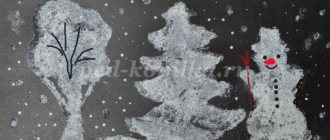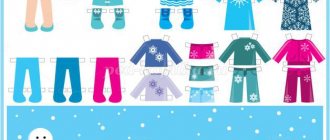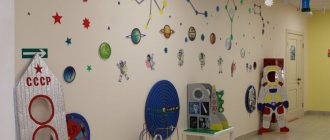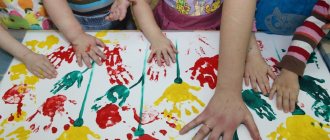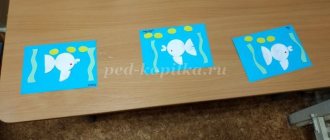Summary of a drawing lesson in the second junior group “Rockets are flying into space”
Tatiana Kuznetsova
Summary of a drawing lesson in the second junior group “Rockets are flying into space”
Goal: Expand children's understanding of the world around them ( space )
Tasks: Fix to draw objects consisting of geometric shapes (narrow rectangle, circles, triangles)
Continue teaching children to navigate on a piece of paper.
Strengthen primary colors (blue, red, yellow)
Develop an eye. Cultivate curiosity, accuracy, and artistic taste.
Preliminary work: Conversation about space (in an accessible form)
Looking at pictures about
space . Didactic game “Build
a rocket from counting sticks ” Materials: Sheets of gray and black paper. Gouache paints (blue, red, yellow)
Paper napkins for each child; brushes of different sizes No. 2, 3; jars of water.
Thematic lesson “Space”
The first thing you should tell your child when studying space is that our earth is spherical. Take a globe and show on it the land, on which there are mountains, rivers, forests, deserts, and the blue surface - this is all water - seas and oceans. Walk your fingers around the globe to the rhyme:
We walk around the globe, raising our fingers together. We jumped over a forest, climbed a mountain, found ourselves in the ocean - We went swimming together. We went to Antarctica, it was cold, we were frozen. We all boarded the rocket and flew off into space (raise the handle up).
Tell your child that around us is space. It is very big. And there are many planets in space. One of them is our Earth. We hung up the “Planets of the Solar System” poster for the child and looked at it.
Let's recite a poem about the planets:
In order, all the planets can be named by any of us: One - Mercury, Two - Venus, Three - Earth, Four - Mars. Five is Jupiter, Six is Saturn, Seven is Uranus, followed by Neptune. He is the eighth in a row. And behind it, then, is the ninth planet called Pluto.
My child and I drew these planets: we depict the sun in the center, draw the orbits in which the planets rotate with a compass, draw planets on each line, saying where the small planet is and where the big one is. You can play with balls - put a large ball in the center - the Sun. We make orbits from threads. We put balls of different sizes on them. We roll them in orbits. A baby can also be a planet - run around in its orbit - this is how we remember the names of the planets.
There are also stars in space - fireballs.
Day and night. Tell your child why there is day and night. My son and I took a globe in the dark and a flashlight. We talk about the fact that the Earth rotates around its axis - we show how. We shine a flashlight on one part of the globe - in this part of the earth it is now day, and in the opposite part it is night.
Winter and summer. Now we will move the globe around the “sun” and observe what happens to the lighting. Due to the fact that the sun illuminates the surface of the Earth differently, the seasons change. If it is summer in the Northern Hemisphere, then in the Southern Hemisphere, on the contrary, it is winter.
We laid out planets and comets from a mosaic:
We made applications on the theme “Space”.
Moon. We roll a ball out of plasticine, on which we make dents - craters - with a pencil. The lid was sealed with plasticine - it turned out to be a flying saucer on which we put aliens.
We make a comet from plasticine - a spaghetti tail.
We're talking about constellations . We glue the stars in a chaotic order and connect them into a constellation with a felt-tip pen. Plasticine stars were attached to the pictures.
Game "Pick up a constellation". It is necessary to connect the constellation with the corresponding picture.
Game "Space Puzzles"
Game with meteorites. We draw craters on the sheet in which we make cuts. We make meteorites for them. The task is to match each crater with its own meteorite based on the number of points on it. We put them in funnels.
Ship with the Nikitin Unicube. You need to place cubes on a rocket with multi-colored squares so that its top and side faces are the same color.
Game “Connecter” - connect a syllable with a picture.
We make words from Zaitsev's cubes:
Outdoor game “Collect the stars” - cut out several stars and number them. Place it around the room in hard to reach places. To collect all the stars, the baby needs to climb onto a chair and get it, reach it, push it with a stick, climb onto the wall bars.
Game "Flying Comet". Take a balloon and attach a juice or cocktail straw to it with tape. Thread a thread into the tube and attach the edges in different parts of the room, preferably at an angle. We let the ball fly - it “flies” to the other end along a string. My child had a lot of delight!
We make rockets with our own hands from a cardboard tube and colored paper:
We lay out pictures from counting sticks :
Educational game "Space". My son really likes to play the game “Space” with reusable stickers. It has a playing field and various figures - astronauts, aliens, a flying saucer, planets, a rocket, meteorites, asteroids, etc. Thanks to reusable stickers, we create interesting and unusual variants of gaming situations.
We play “Astronomers” - we put on the child a cap decorated with stars and a cloak (made from a sheet). We take a cardboard tube - this will be our telescope. Decorate it with your child with stars or simply paint it with paints. I drew space images (comets, stars, moon, etc.) on a chalkboard. The child observed them through a “spyglass,” then turned away and guessed what had changed.
Performed the following tasks:
Find differences:
Count how many starships have already landed on an unknown planet. How many starships have not yet landed. Show the required numbers.
Tell the alien what these objects are called, how they are similar, how they are different.
Circle the craters on the lunar surface:
Count how many rockets are flying to the right, how many to the left, up and down.
Help the flying saucers make an accident-free landing - fill in the required number of dots in the empty windows. Their total number must correspond to the indicated figures.
Find the missing rocket:
